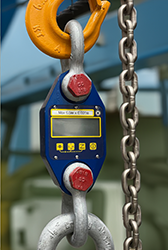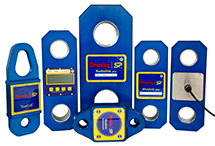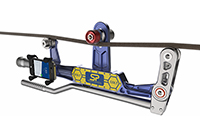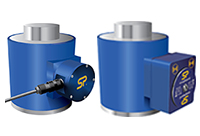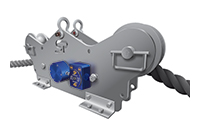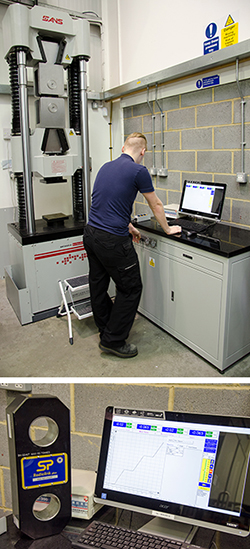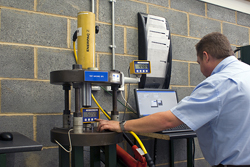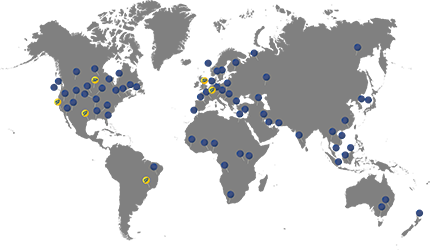The process of calibration in any parameter is to compare an unknown instrument (known as “unit under test”) against a known instrument (usually known as a “reference standard”)
This will then determine the accuracy and /or repeatability of the unit under test.
The reference standard therefore must be verified as accurate at given intervals, and the calibration must be traceable back to national standards held by the National Physical Laboratory or NPL.
Traceability
Calibration of all SP test rigs are carried out annually by a UKAS 3rd party calibration providor to:
- ISO7500-1:2015
- ASTM E4:14
The 3rd party calibration company shall use reference standards that are verified themselves to:
- ISO376:2011
- ASTM E74:13a
This is the basis of traceability in calibration.
When SP create any certificate of calibration, they make reference to the testing machine used and the traceability back to the 3rd party calibration body.
By doing this SP create traceability of calibration, which then assures the customer that their calibration could be traced back to national standards if required.
This refers to the statement on certification “all measurements are traceable to national standards”
Calibration interval should not exceed 12 months.
The frequency of calibrations should be determined by the user of the load cell based on the following factors:
- Frequency of use
- Severity of service conditions
- Nature of loading
- Experience gain using other similar products in same application
Once these factors are established the user may then establish the calibration frequency:
- Normal use – calibration every 12 months
- Severe use – calibration monthly to quarterly
- Special service – as recommended after consultation with SP engineering team and user.
A written record of the most recent periodic inspection shall include the condition of the load cell.
These guidelines fall in-line with ASME and LOLER recommendations.
A complete inspection of the load cell shall be performed by a designated person trained to National Standards. The load cell shall be examined for conditions such as those listed below and a determination made as to whether they constitute a hazard.
Removal Criteria:
A load cell and its indicator, if applicable, shall be removed from service if damaged such as the following is visible and shall only be returned to service when approved by a qualified person:
- Missing or illegible manufacturers name/trademark, or serial number, or rated load identification.
- Indications of heat damage, including weld splatter or arc strikes.
- Excessive pitting or corrosion.
- Bent, twisted, distorted, stretched, elongated, cracked, or broken load-bearing components.
- Excessive nicks or gouges.
- Any reduction of the original or catalogue dimension at any point outside of the load-sensing zone.
- Illegible display or readout.
- Damaged of deformed component hardware.
- Evidence of unauthorised welding.
- Other conditions, including visible damage that cause doubt as to the continued use of the load cell.
Q. Do you hire or rent load cells?
A. No we don't. However, many of our partners offer load cell hire or rental so we can connect you with one of them.
Q. Do your load cells come with a calibration certificate and carry case?
A. Yes, all Crosby SP load cells come with a certificate of calibration, proof test & EC declaration of conformity. Depending on the WLL they are supplied in either an aluminium case or wooden shipping crate.
Q. What is the availability of your products?
A. Our standard range of products are in stock at our UK and USA facilities up to 500t capacity and can usually be despatched within 3 working days from receipt of order.
Q. Where are your products manufactured?
A. Crosby SP Manufacturing Plant, United Kingdom - See our short video here
Q. Can you calibrate my load cell, it’s not a Crosby Straightpoint?
A. We can adjust the readings on many other manufacturers' products (providing we hold the adjustment details) If we do not hold these details, then a calibration certificate of ‘as found’ readings will be supplied.
Q. Do you charge inspection fees for repairs?
A. No. We will inspect a faulty load cell and raise a no-obligation quote FOC. If the work is declined, we only charge for return carriage (if applicable).
Q. What is the environmental protection of your load cells?
A. Our wireless range of load cells is rated IP67 or NEMA6, and our self-indicating load cells are rated IP65 or NEMA4X. We can manufacture load cells to higher ratings, if necessary, for applications in radius areas or even subsea. Ratings explained here >
Q. Is it possible to control more than one Bluetooth Load Cell and see the active weight with one smartphone with the HHP app?
A. Currently, no this is not possible. The app and loadcell are one-to-one.
Q. Is it possible to see the active weight of one Bluetooth Load Cell with more than one smartphone with the HHP app? (ex: 4 smartphones with HHP app)
A. Currently, no this is not possible. The app and loadcell are one-to-one.
Q. Does the Bluetooth Load Cell have "Awake" and "Sleep" mode?
A. For battery saving, the Bluetooth Low Energy PCB has internal auto sleep-wake available and this is on whenever the HHP app is in use. When polled by the app the Bluetooth PCB will automatically turn on and send data.


